Epilepsy is a chronic diseasethat affects the brain. Its peculiarity is in excessive neural discharges that affect human behavior.
The main manifestations of the disease are recurrent seizures, lingering psychosis and other symptoms, including serious personality disorders. Among the population, epilepsy is observed in 1%. In half of the cases, the first manifestations of the disease are observed in childhood and even infancy.
Record content:
-
1 Causes of occurrence in newborns
- 1.1 Genetic predisposition
- 1.2 Birth trauma
- 1.3 Brain infection
- 1.4 Brain inferiority
- 1.5 Skull injuries
- 1.6 Unclear reasons
-
2 Types and forms of epilepsy
- 2.1 Dravet syndrome
- 2.2 Benign myoclonus epilepsy of infancy
- 2.3 Doose syndrome
- 2.4 Benign familial seizures
- 2.5 Benign non-familial seizures
- 2.6 Otahara syndrome
- 2.7 West syndrome
- 2.8 Idiopathic benign partial epilepsy
- 2.9 Early epileptic encephalopathy
- 2.10 Vitamin B6 Dependent Epilepsy
- 2.11 Malignant vagus partial seizures
- 3 How to distinguish newborn epilepsy from physiological changes
- 4 Difference in symptoms for different forms of the disease
-
5 Factors and risk groups
- 5.1 "Major" epilepsy
- 5.2 "Minor" epilepsy
- 5.3 Nocturnal epilepsy
- 5.4 Temporal lobe epilepsy
- 6 What symptoms should you contact a neurologist
- 7 Possible consequences and complications
- 8 Epilepsy Videos
Causes of occurrence in newborns
Seizures can occur for a variety of reasons.
Among them:
- traumatic brain injury;
- tumors;
- infections;
- problems with blood vessels;
- toxic processes;
- birth and postnatal trauma;
- abnormal development of the fetus;
- suffocation.
High convulsive readiness plays an important role in the development of the disease. It depends on a certain heredity or changes in the nervous system and metabolic processes during life.
Epilepsy in children can be quite common. The patient will have the first convulsions before the age of 20. They can usually be dealt with with the right drugs. But in order to determine the necessary drugs, including for infants, it is necessary to establish the cause and symptoms of the disease.
Genetic predisposition
Epilepsy in infants, the symptoms of which will be discussed below, is most often associated with genetics. Doctors assume that it is not the disease itself that is hereditarily transmitted, but only a predisposition to it. Convulsive activity is present in every person, but additional factors can provoke it.
Birth trauma
Such causes are not uncommon for epilepsy. Hemorrhages, bone fractures, nerve trauma, spinal cord and brain damage, prolonged attempts, as well as prolonged presence of the child's head in the joint of the pelvic bones.
Brain infection
Neural disruptions often occur due to various infectious diseases in the brain. Bacterial or fungal microflora can harm the nervous system during illness and even after the body is cured.
Brain inferiority
This pathology is almost impossible to correct, because it can arise even during intrauterine development. It can develop due to the mother's hobbies for smoking, drugs, alcoholic beverages.
Skull injuries
Another reason that provokes epileptic seizures. Skull injuries in the neonatal period can provoke disorders of the brain structures. In this case, epilepsy may not appear immediately, but after a while.
Unclear reasons
The idiopathic factor is quite common in epilepsy. In this case, treatment is undertaken according to the symptoms, but the cause of the disease cannot be established.
Types and forms of epilepsy
Epilepsy in infants, the symptoms of which depend on the forms of the disease, can have several manifestations. The most popular ones are worth considering.
Dravet syndrome
Severe pathology, leading to difficulties in psychomotor development, and sometimes to death. Appears at 2-10 months. Features - multiple attacks during the day.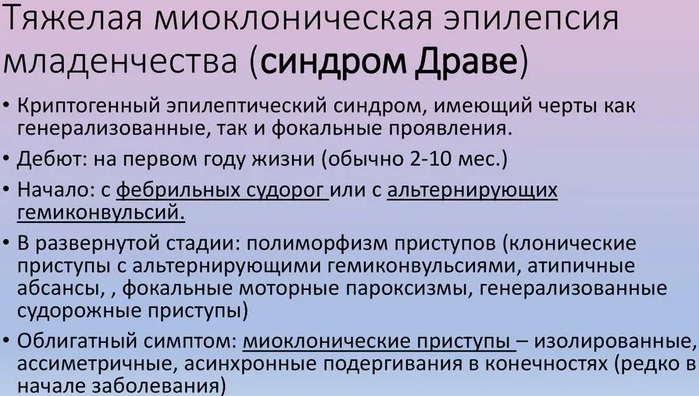
This condition can last for several days in a row (up to a week). Then a short break - 2-3 weeks, and everything is repeated again. Convulsions may be present or everything is bypassed by muscle twitching and impaired consciousness.
Benign myoclonus epilepsy of infancy
It manifests itself before the age of 3 years (early manifestations occur at 4-11 months). Illness is not preceded by psychomotor disorders. It is considered an idiopathic or symptomatic form of the disease and is milder than Dravet syndrome. Typical signs are short-term myoclinic (limping legs) seizures involving the head and arms.
Doose syndrome
It occurs in children aged 1-5 years. The disease is characterized by short-term convulsions, up to several times a minute, nodding movements occur. Consciousness does not suffer in this case.
Epileptic seizures in this case are associated with diseases of the central nervous system, impaired motor functions, mental retardation.
Benign familial seizures
Observed from the age of 3 days of the baby. Their appearance is associated with the presence of epileptic seizures in family members of the newborn. The attacks do not last long - 1-2 minutes, but their number can reach up to 30 per day. Seizures disappear 1-3 weeks after the onset.
Benign non-familial seizures
Observed on the 5th day after birth. Accompanied by muscle contractions in the limbs and on the face, then on the right, then on the left. Repeated throughout the day. They disappear completely after 2 weeks.
Otahara syndrome
A rare malignant disease. It appears in the first months of life. It is characterized by tonic seizures in the amount of 10-300 per day. The child has serious abnormalities in the formation of the central nervous system. 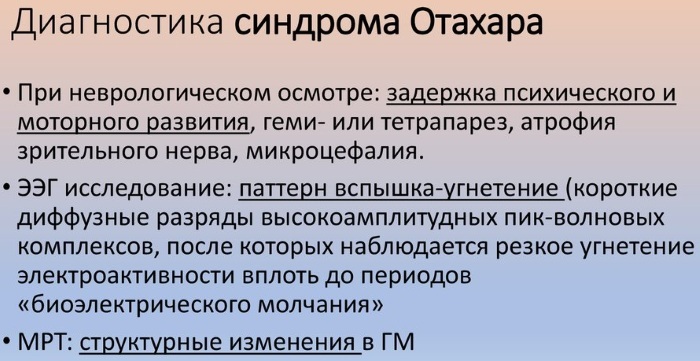 With age, the risk of mortality increases (up to 40-50%).
With age, the risk of mortality increases (up to 40-50%).
West syndrome
Catastrophic epilepsy, which is noticeable at the age of 3-8 months. Accompanied by flexion and extension movements. It can develop with or without problems with the central nervous system. Consequences - delayed development of psychomotor functions, the appearance of signs of cerebral palsy. The prognosis of the disease is not favorable.
Idiopathic benign partial epilepsy
Their collective name is "Watanabe syndrome". They make themselves felt at the age of 3-20 months. They are characterized by complex partial seizures, moderate seizures, cessation of motor activity, and blue discoloration of the skin.
Early epileptic encephalopathy
Registered in the neonatal period of development. It is characterized by a high degree of lethality. A genetic factor plays a significant role in the onset of the disease. It is accompanied by myoclonic seizures, often fragmented, but gaining intensity with age. Focal seizures, the center of which is located in the brain, are the main ones for the disease.
Vitamin B6 Dependent Epilepsy
An inherited disease may appear after 1 month of life. It is typical for children whose mothers took pyridoxine during pregnancy. Children remain restless between attacks, reacting to external irritants with muscle contractions.
The disease is not treated with conventional anticonvulsants and recedes with high doses of vitamin B6 (25 mg / kg per day).
Malignant vagus partial seizures
A very rare disease, only 50 cases are known in the world. Half of them fell on the first days of life, the other half - at the age of 1-3 months. It begins with the manifestation of one (focal) focus of seizures, and then turns into a multifocal (multifocal) form.  The disease demonstrates resistance to drugs, does not create metabolic problems.
The disease demonstrates resistance to drugs, does not create metabolic problems.
How to distinguish newborn epilepsy from physiological changes
A child under one year old is seriously different in behavior from older children - 2-3 years old. He often makes unconscious movements with his arms and legs. And distinguishing normal development from an epileptic seizure can be tricky. But there are universal signs of the onset of a seizure.
| The main signs | Additional signs |
| Sudden immobilization - the child seems to freeze. | Breathing problems, up to and including stopping. |
| The gaze focuses on one direction. | Temperature increase |
| The eyes begin to roll over the upper eyelids. | Frequent urination and defecation. |
| There is no reaction to stimuli - light, sound, movement. | Convulsions |
| Loss of consciousness |
After an attack, the child's normal activity resumes.
Difference in symptoms for different forms of the disease
Epilepsy in infants, the symptoms of which differ depending on the form of the disease, can be identified by the nature of the seizures.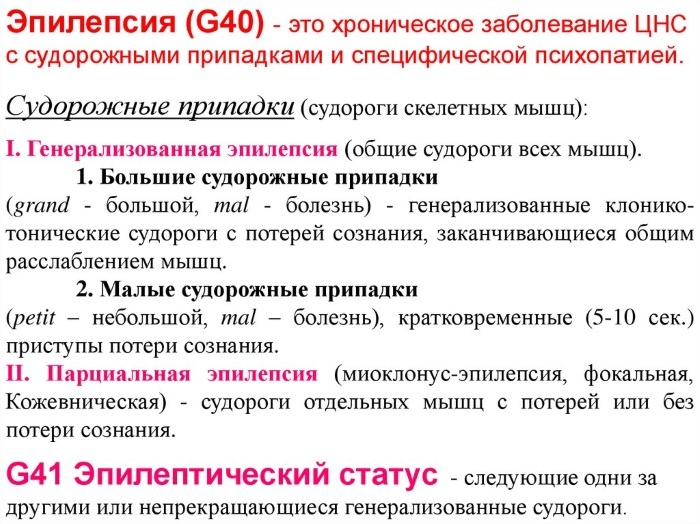
| Seizures are common | Focal seizures | |
| Large | Small | |
| Sharp muscle tension for 10-30 seconds. | Disconnection of consciousness for a short period. | Convulsions or immobilization of any part of the body. |
| Loss of consciousness | Decreased muscle tone. | Right-left movement of the head and eyes. |
| Rhythmic contraction of muscles and limbs for 2-5 minutes. | Brief tension of all muscles. | Conduct disorders |
| Heavy sleep | Motor seizures are repetition of the same actions. | |
| Loss of orientation in space. |
Factors and risk groups
Not every child can experience epilepsy.
There are a number of factors that increase the risk of epilepsy from infancy:
- convulsions;
- epileptiform activity on the electroencephalogram;
- score within 0-3 on the Apgar scale;
- severe prematurity, less than 31 weeks;
- resuscitation at birth;
- family history of epilepsy;
- transferred infections while in the womb, such as herpes encephalitis;
- mental difficulties;
- limitation of movement or paralysis of the limbs with cerebral palsy.
"Major" epilepsy
It is also called "true".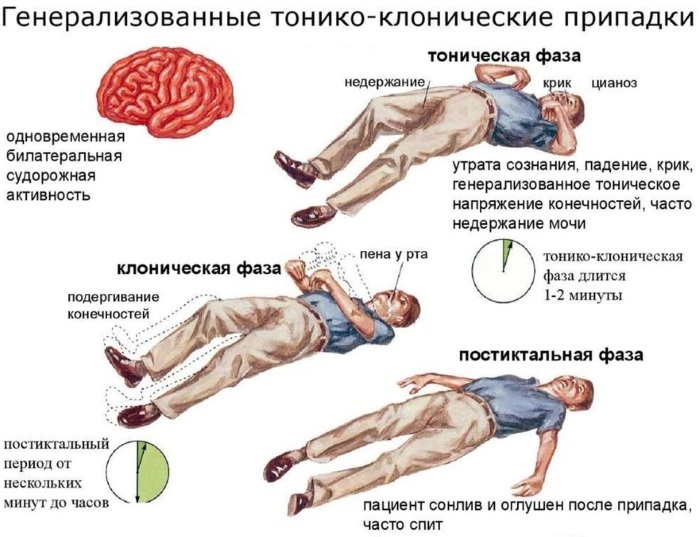
This epilepsy is accompanied by all sorts of seizures:
- tonic - individual muscle groups straighten and become immobile;
- clonic - some muscles begin to constantly contract;
- mixed - one type of seizures is replaced by another.
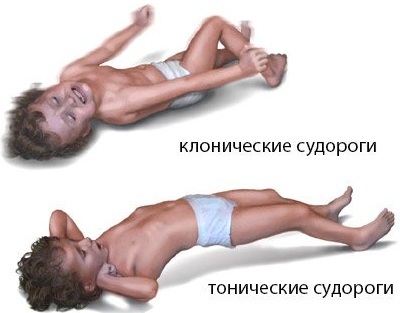
Also, with "large" epilepsy, the child may experience concomitant unpleasant conditions:
- dizziness, up to loss of consciousness;
- involuntary discharge of urine and saliva;
- stopping breathing for a short time;
- biting the tongue with bloody foam at the mouth.
"Minor" epilepsy
This type of disease is characteristic exclusively of childhood. Its peculiarity is that only certain muscle groups come to an excited state.
Manifestations of "minor" epilepsy:
- turning the child's head to one side;
- unblinking look;
- motionless stay in one position;
- one of the muscle groups either suddenly tenses or relaxes abruptly;
- less often there are abdominal cramps and subsequent vomiting;
- increased heart rate;
- increased body temperature;
- increased sweating.
Nocturnal epilepsy
This type of pathology is activated during sleep, which indicates the presence of its focus in the frontal lobes of the brain. Traditionally, nocturnal epilepsy is considered one of the mildest forms that can be treated with medication. True, you need to undergo a long course of therapy under the supervision of specialists.
Features of nocturnal epilepsy:
- a seizure may occur before waking up;
- trembling of the legs when falling asleep and dysfunction of the limbs on awakening;
- restless sleep;
- the presence of signs of sleepwalking (talking or walking in a dream).
In the absence or suspension of treatment, complications in the form of waking up in a bad mood or self-harm are possible.
Temporal lobe epilepsy
Differs in a more severe course over time, as well as the presence of prolonged attacks.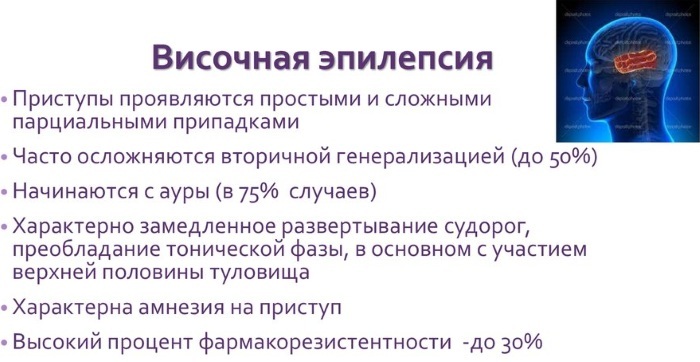
Convulsions are preceded by:
- active heartbeat;
- violation of the swallowing reflex;
- pain in the abdomen;
- vomiting;
- shortness of breath;
- increased sweating.
The specific features of epilepsy are simple and complex seizures.
Simple attacks include:
- the appearance of an anxious mood;
- loss of orientation in space;
- movement of the head and eyes in the direction of the focus of the disease.
Complex seizures are repetitive movements:
- swallowing;
- smacking;
- chewing;
- unnatural chuckles;
- pronouncing the same sound;
- blinking;
- pat;
- scratching.
What symptoms should you contact a neurologist
Epilepsy can appear in the first days of life or much later - at 2-6 months. And it is important to know what symptoms in a child's condition will be indicative for referring to a neurologist.
Here are the main ones:
- the child constantly nods his head;
- the nasolabial triangle becomes bluish;
- the shoulders twitch frequently and unnaturally.
Possible consequences and complications
Timely treatment of epilepsy in infancy will help to avoid its manifestations in adulthood. 75% of babies are successfully cured and by the age of 12 they no longer experience any symptoms of the disease.
Depending on the form of the disease, its course, the increase or complete attenuation of symptoms, grown children can go to specialized institutions under the supervision of specialists or to a regular kindergarten and school.
However, complications that arise after seizures can be quite dangerous:
- Arm and leg injuries sustained during seizures.
- Impaired mental development and difficulty in mastering speech.
- Deterioration of the mental state.
- The transition of the disease from a child's form to an older one.
- Onset of status epilepticus (a series of seizures lasting about 30 minutes).
- Death of a patient due to injury or respiratory arrest.
With infants who have symptoms of epilepsy only once, preventive measures should be taken regularly. Hiking, visiting forests, parks will be useful. You can go in for outdoor games, swimming, accompanied by adults.
Epilepsy Videos
Diagnosis and treatment of epilepsy:



